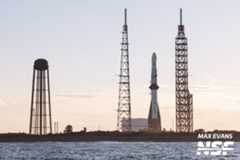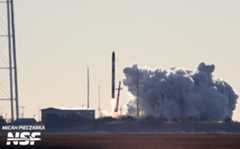Launch Roundup: New Glenn, Viasat, & Sentinel-6B highlight busy week of launches
This week’s launch schedule featured two high-profile launches that were pushed back after scrubs from last week, as well as the Sentinel-6B mission and two Starlink missions for SpaceX. A suborbital Electron HASTE mission from Wallops is also scheduled.
New Glenn’s second launch, featuring the Mars-bound ESCAPADE payload, was scheduled to launch no earlier than Wednesday, Nov. 12 but that was pushed back to Thursday, Nov. 13, when it successfully launched. The Viasat-3 F2 mission, launching on a United Launch Alliance (ULA) Atlas V, was scheduled for Nov. 13, and it successfully launched.
There are two Starlink launches following on Friday, Nov. 14 and Saturday, Nov. 15, with the first one already flown. The Electron and Sentinel launches are expected to end out the week, and Sentinel-6B launched successfully on Sunday, Nov. 16.
Transporter-15’s launch is now scheduled for no earlier than Nov. 22, and other launches had their times rescheduled due to the U.S. government shutdown; a deal to end the shutdown was passed and signed on Nov. 12. The Federal Aviation Administration (FAA) issued an emergency notice on Thursday, Nov. 6, banning launches from 6:00 AM to 10:00 PM local time.
The FAA issued the ban, which is scheduled to take effect on Monday, Nov. 10, due to staffing issues caused by air traffic controllers and other government employees going without pay during the government shutdown. However, now that the shutdown has ended, it is expected that the FAA will lift the ban when staffing levels improve.
Blue Origin successfully launched the Escape and Plasma Acceleration and Dynamics Explorers (ESCAPADE) mission, the second-ever flight of its heavy-lift New Glenn rocket, for Thursday, Nov. 13, at 3:55 PM EST (21:55 UTC) from Launch Complex 36 (LC-36) at the Cape Canaveral Space Force Station (CCSFS) in Florida. The launch window closed at 4:25 PM EST (21:25 UTC). This attempt followed a scrub on Sunday, Nov. 9, due to weather issues, and the Nov. 12 attempt was also scrubbed due to a solar storm after an X5 flare.
New Glenn, with the Glenn Stage 1 (GS1) first stage booster namedNever Tell Me The Odds, will flew due east out of the Cape, safely separating the two ESCAPADE probes, namedBlueandGold, on a trajectory to the Sun-Earth Lagrange Point 2 (L2), located 1.5 million km from Earth. GS1 successfully landed on Blue Origin’s Landing Platform Vessel 1 (LPV-1) barge, namedJacklyn after Jeff Bezos’ mother, out in the Atlantic. This makes New Glenn the second orbital-class rocket to successfully land on a barge after a launch.

New Glenn on the pad at LC-36 before its first launch attempt on Nov. 9. (Credit: Max Evans for NSF)
The probes were built to study Mars, but since the launch did not fall in the normal transfer window that occurs every 26 months, the spacecraft will study space weather at L2 before flying to Mars during the 2026 Mars transfer window.
ESCAPADE, a mission led by NASA and the University of California, Berkeley, will send two Rocket Lab-built probes, namedBlueandGold,into orbit around Mars for a three-year primary mission to study the Martian magnetosphere and how the solar wind interacts with it and Mars’ thin atmosphere.
This marks the second flight for New Glenn, and the rocket’s second flight in 2025. A successful booster landing onJacklyn marked the first time a New Glenn booster has successfully landed. Blue Origin hopes to fly more New Glenn rockets with an improved cadence in 2026.
ULA’s fifth launch of the year — and Atlas V’s fourth — took place on Thursday, Nov. 13, at 10:04 PM EST (03:04 UTC on Friday, Nov. 14) following launch scrubs caused by issues with a liquid oxygen vent valve during launch attempts on Wednesday, Nov. 5, and Thursday, Nov. 6. These issues caused the Atlas V to roll back to the vehicle integration facility building at Space Launch Complex 41 (SLC-41).
Atlas V tail number AV-100 launched from SLC-41, located at CCSFS, and flew on a due east trajectory. The launch window for this mission lasted until 12:05 AM EST on Friday, Nov. 14 (05:05 UTC).
Atlas V lofted the Viasat-3 F2 satellite into a geosynchronous orbit. The Atlas V 551, the most powerful variant of the Atlas V family, uses five solid rocket boosters and a five-meter wide fairing along with a single-engine Centaur upper stage. The variant, affectionately known as the “Bruiser” at ULA, is needed to lift the 6,400 kg Viasat-3 F2 to geosynchronous orbit.
The Viasat-3 F2 satellite, manufactured by Boeing and based on the 702P+ platform, is designed to add up to one terabit per second of network capacity to the company’s network. This particular satellite, operating in the Ka-band, will serve the Americas and is designed to offer download speeds of over 100 megabits per second. There are also over 1,000 steerable spot beams for connectivity to mobile platforms.
Viasat-3 F2 is the second satellite of this constellation to fly. The Viasat-3 F1 satellite was launched on a SpaceX Falcon Heavy on May 1, 2023, and was itself intended to serve the Americas. However, Viasat-3 F1 suffered an anomaly during its antenna deployment sequence, reducing its capacity by around 90 percent.
Viasat-3 F1 is still used for government and aviation customers and will be moved to support Europe, the Middle East, and Africa after Viasat-3 F2 is operational. The forthcoming Viasat-3 F3 will serve the Asia-Pacific region.
The Viasat-3 F2 launch vehicle marked the final Atlas V mission to fly a satellite to geosynchronous orbit. There are 11 Atlas V missions left after this flight, all of them either Atlas V 551s for Project Kuiper missions or Atlas V N22s for Boeing Starliner flights.
Falcon 9 | Starlink Group 6-89
The first Falcon 9 launch of the week is the Starlink Group 6-89 mission, which flew successfully on Friday, Nov. 14, at 10:08 PM EST (03:08 UTC on Saturday, Nov. 15) from Launch Complex 39A (LC-39A) at the Kennedy Space Center in Florida. The launch window lasted until 2:01 AM EST on Friday, Nov. 14 (07:01 UTC).
Starlink Group 6-89, flying with Falcon booster B1092, launched on a southeast trajectory with 29 Starlink v2 Mini satellites on board. B1092-8 landed safely atop SpaceX’sA Shortfall of Gravitas autonomous droneship out in the Atlantic. This launch was the 145th Falcon 9 launch of 2025, the 150th SpaceX mission of the year, and the first of two Falcon 9 launches in quick succession from the Florida coast.
Falcon 9 | Starlink Group 6-85
The second Falcon 9 launch of the week, successfully occurring in the early hours of Saturday, Nov. 15, was Starlink Group 6-85. Liftoff happened at 1:44 AM EST (06:44 UTC) from Space Launch Complex-40 (SLC-40) at CCSFS, a little over three hours after Starlink 6-89’s launch. Like Starlink Group 6-89, this mission’s window lasted until 2:01 AM EST Saturday, Nov. 15 (07:01 UTC).
Booster B1078 supported this mission on its 24th flight. Falcon 9 flew on a southeasterly trajectory with 29 Starlink v2 Mini satellites on board.
The booster safely landed atop SpaceX’sJust Read the Instructions droneship in the Atlantic. This launch marked the 146th Falcon 9 launch of 2025.

Sentinel-6B during prelaunch processing before its launch from VSFB. (Credit: USSF 30th Space Delta)
The Copernicus Programme, run by the European Commission, and SpaceX launched the Sentinel-6B Earth-observation satellite from Vandenberg Space Force Base (VSFB) in California on Monday, Nov. 17. Falcon 9 lifted off from Space Launch Complex 4 East (SLC-4E) at 9:21 PM PST (05:21 UTC on Monday, Nov. 17). The launch window ended at 9:32 PM PST (05:32 UTC on Tuesday).
The launch of Sentinel-6B was not affected by the FAA staffing issues, since licensing was acquired through NASA, and the launch was procured through NASA’s Launch Services Program.
Falcon 9 booster B1097 flew on a southeast trajectory to place Sentinel-6B in a 1,336 km altitude circular orbit inclined 66 degrees to the equator. After stage separation, B1097, flying on its third mission, conducted a return-to-launch-site maneuver and landed safely at Landing Zone 4 (LZ-4), which is located directly adjacent to SLC-4E. Sentinel-6B was successfully deployed just over 57 minutes after launch.
Sentinel-6B will study ocean topography and monitor sea levels using radar altimetry in cooperation with NASA and other agencies worldwide. The mission will ensure sea level data continuity from 1992 until at least 2030 with the aging Jason-3 and Sentinel-6AMichael Freilich satellites in orbit. This flight was the 147th Falcon 9 launch of 2025.

Electron HASTE mission Van launches from LC-2 at Wallops on Nov. 18, 2025. (Credit: Micah Pieczarka for NSF)
Rocket Lab flew a HASTE suborbital hypersonic research mission, named “Van,” from Launch Complex-2 (LC-2) at the Wallops Flight Facility in Virginia. The flight successfully launched on Tuesday, Nov. 17, at 8:00 AM EST (13:00 UTC), with the rocket flying due east over the Atlantic, after being delayed from Monday due to high winds.
Rocket Lab’s HASTE missions are designed to conduct research testbed flights, studying hypersonic flight for military applications. Four of these missions had flown prior to this, and Van was the fifth. At least one more HASTE mission, Dart AE, could be flown before the end of the year.
This flight was the third from LC-2 in 2025, after the Jenna and Justin HASTE missions in September. It was the 17th Electron launch of 2025, breaking Rocket Lab’s record of 16 flights for Electron in 2024. Rocket Lab could fly several additional Electrons before the end of 2025 as the company prepares for the first flight of its medium-lift Neutron rocket.
(Lead image: New Glenn launches on its first mission, NG-1, in January 2025. Credit: Max Evans for NSF)







